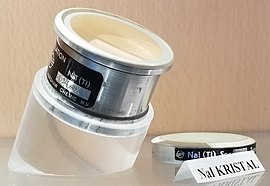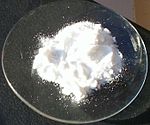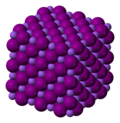സോഡിയം അയോഡൈഡ്
| |||
 NaI(Tl) scintillators
| |||
| Identifiers | |||
|---|---|---|---|
| |||
3D model (JSmol)
|
|||
| ChEBI | |||
| ChEMBL | |||
| ChemSpider | |||
| ECHA InfoCard | 100.028.800 | ||
PubChem CID
|
|||
| RTECS number |
| ||
| UNII | |||
CompTox Dashboard (EPA)
|
|||
| InChI | |||
| SMILES | |||
| Properties | |||
| തന്മാത്രാ വാക്യം | |||
| Molar mass | 0 g mol−1 | ||
| Appearance | white solid deliquescent[1] | ||
| Odor | odorless | ||
| സാന്ദ്രത | 3.67 g cm−3[1] | ||
| ദ്രവണാങ്കം | |||
| ക്വഥനാങ്കം | |||
| 1587 g/L (0 °C) 1842 g/L (25 °C) 2278 g/L (50 °C) 2940 g/L (70 °C) 3020 g/L (100 °C)[2][3] | |||
| Solubility | ethanol, acetone[1] | ||
| Band gap | 5.89 eV[4][5] | ||
| −57×10−6 cm3 mol−1[6] | |||
| Refractive index (nD) | 1.93 (300 nm) 1.774 (589 nm) 1.71 (10 μm)[7] | ||
| Structure | |||
| Halite, cF8 | |||
| Fm3m, No. 225 | |||
a = 0.6462 nm
| |||
Formula units (Z)
|
4 | ||
| Octahedral | |||
| Thermochemistry | |||
| Std enthalpy of formation ΔfH |
−287.8 kJ mol−1 | ||
| Standard molar entropy S |
98.5 J mol−1 K−1 | ||
| Specific heat capacity, C | 52.1 J mol−1 K−1 | ||
| Hazards | |||
| Main hazards | Irritant, can harm the unborn child | ||
| Safety data sheet | [1] | ||
| GHS pictograms |  
| ||
| GHS Signal word | Danger | ||
| H315, H319, H400 | |||
| P273, P305+351+338[9] | |||
| Flash point | {{{value}}} | ||
| Related compounds | |||
| Other anions | Sodium fluoride Sodium chloride Sodium bromide Sodium astatide | ||
| Other cations | Lithium iodide Potassium iodide Rubidium iodide Caesium iodide Francium iodide | ||
Except where otherwise noted, data are given for materials in their standard state (at 25 °C [77 °F], 100 kPa).
| |||
സോഡിയം ലോഹത്തിന്റെയും അയോഡിന്റെയും രാസപ്രവർത്തനഫലമായി രൂപം കൊള്ളുന്ന ഒരു അയോണിക് സംയുക്തമാണ് സോഡിയം അയഡൈഡ് ( NaI ). ഇത് പ്രധാനമായും പോഷക സപ്ലിമെന്റായും ഓർഗാനിക് കെമിസ്ട്രിയിലും ഉപയോഗിക്കുന്നു. അസിഡിക് അയോഡൈഡുകൾ സോഡിയം ഹൈഡ്രോക്സൈഡുമായി പ്രതിപ്രവർത്തിക്കുമ്പോൾ ഉണ്ടാകുന്ന ലവണം എന്ന നിലയിലാണ് ഇത് വ്യാവസായികമായി ഉൽപ്പാദിപ്പിക്കപ്പെടുന്നത്.
ഉപയോഗം
[തിരുത്തുക]ഫുഡ് സപ്ലിമെന്റ്
[തിരുത്തുക]സോഡിയം അയഡൈഡും അതുപോലെ പൊട്ടാസ്യം അയഡൈഡും അയോഡിൻറെ കുറവ് പരിഹരിക്കുന്നതിനും തടയുന്നതിനും സാധാരണയായി ഉപയോഗിക്കുന്നു. അയോഡൈസ്ഡ് ഉപ്പിൽ 10 പിപിഎം അയഡൈഡ് അടങ്ങിയിരിക്കുന്നു.
ഓർഗാനിക് സിന്തസിസ്
[തിരുത്തുക]
ആൽക്കൈൽ ക്ലോറൈഡുകളെ ആൽക്കൈൽ അയോഡൈഡുകളാക്കി മാറ്റാൻ സോഡിയം അയഡൈഡ് ഉപയോഗിക്കുന്നു. ഫിങ്കൽസ്റ്റൈൻ പ്രതികരണം എന്ന ഈ രീതി, , [11] അസെറ്റോണിലെ സോഡിയം ക്ലോറൈഡിന്റെ അലേയത്വത്തെ ആശ്രയിച്ചിരിക്കുന്നു: [12]
- R–Cl + NaI → R–I + NaCl
ന്യൂക്ലിയർ മെഡിസിൻ
[തിരുത്തുക]Na125I , Na131I എന്നിവയുൾപ്പെടെയുള്ള സോഡിയത്തിന്റെ ചില റേഡിയോ ആക്ടീവ് അയഡൈഡ് ലവണങ്ങൾ, തൈറോയ്ഡ് കാൻസറിനും ഹൈപ്പർതൈറോയിഡിസത്തിനും റേഡിയോ ഫാർമസ്യൂട്ടിക്കൽ ( ഇമേജിംഗിൽ റേഡിയോ ആക്ടീവ് ട്രെയ്സർ) ആയി ഉപയോഗിക്കുന്നു.
താലിയം-ഡോപ്ഡ് NaI(Tl) സിന്റില്ലേറ്ററുകൾ
[തിരുത്തുക]താലിയം കലർത്തി സജീവമാക്കിയ സോഡിയം അയഡൈഡ് (NaI(Tl) എന്ന് സൂചിക്കപ്പെടുന്നു. ഇത് അയോണൈസിംഗ് വികിരണത്തിന് വിധേയമാകുമ്പോൾ ഫോട്ടോണുകൾ പുറപ്പെടുവിക്കുന്നു. ഈ പ്രക്രിയയുടെ പേരാണ് സിൻറിലേഷൻ. പരമ്പരാഗതമായി ന്യൂക്ലിയർ മെഡിസിൻ, ജിയോഫിസിക്സ്, ന്യൂക്ലിയർ ഫിസിക്സ്, പാരിസ്ഥിതിക മാപനങ്ങൾ എന്നീ മേഖലകളിൽ പ്രയോജനപ്പെടുന്ന സിന്റില്ലേഷൻ ഡിറ്റക്ടറുകളിൽ ഏറ്റവും വ്യാപകമായി ഉപയോഗിക്കുന്ന സിന്റില്ലേഷൻ പദാർത്ഥം NaI(Tl) ആണ്. സോഡിയം അയഡൈഡ് ഹൈഗ്രോസ്കോപ്പിക് ആയതിനാൽ, NaI(Tl) സാധാരണയായി വായുവിനോ ഈർപത്തിനോ കടക്കാനാവാത്ത വിധം ഭദ്രമാക്കിയ ( ഹെർമെറ്റികലി സീൽഡ്) അവസ്ഥയിലാണ് ഫോട്ടോമൾട്ടിപ്ലയർ ട്യൂബുമായി ബന്ധിപ്പിക്കുന്നത്. ഉയർന്ന സ്പെക്ട്രോമെട്രിക് ഗുണമേന്മയുള്ള എക്സ്-റേ ഡിറ്റക്ടറുകളിൽ ഉയർന്ന തോതിലുള്ള ഡോപ്പിംഗ് ഉള്ള പരലുകൾ ഉപയോഗിക്കുന്നു. സോഡിയം അയഡൈഡ് ഒറ്റ പരലുകളായും ഈ ആവശ്യത്തിനായി പോളിക്രിസ്റ്റലുകളായും ഉപയോഗിക്കാം. [13]
ലേയത്വം
[തിരുത്തുക]ചില ഓർഗാനിക് ലായകങ്ങളിൽ സോഡിയം അയഡൈഡ് കൂടിയ അളവിൽ ലയിക്കുന്നു:
| ലായക | NaI യുടെ ദ്രവത്വം (g NaI/kg ലായകത്തിന്റെ 25-ന് °C) [14] |
|---|---|
| ജലം | 1842 |
| ദ്രാവക അമോണിയ | 1620 |
| ദ്രാവക സൾഫർ ഡയോക്സൈഡ് | 150 |
| മെഥനോൾ | 625-830 |
| ഫോർമിക് ആസിഡ് | 618 |
| അസെറ്റോണിട്രൈൽ | 249 |
| അസെറ്റോൺ | 504 |
| ഫോർമാമൈഡ് | 570-850 |
| അസറ്റാമൈഡ് | 323 (41.5 °C) |
| ഡൈമെതൈൽഫോർമമൈഡ് | 37-64 |
| ഡൈക്ലോറോമീഥെയ്ൻ | 0.09 [15] |
സ്ഥിരത
[തിരുത്തുക]അയോഡൈഡുകൾ (സോഡിയം അയഡൈഡ് ഉൾപ്പെടെ) അന്തരീക്ഷ ഓക്സിജൻനിൽ തന്മാത്രാ അയഡിൻ (I2 ) ആയി ഓക്സിഡൈസ് ചെയ്യപ്പെടുന്നു. സോഡിയം അയഡൈഡിന്റെ വെളുത്ത നിറത്തിൽ നിന്ന് വ്യത്യസ്തമായി മഞ്ഞ നിറമുള്ള ട്രയോഡൈഡ് കോംപ്ലക്സ് രൂപപ്പെടുത്തുന്നു. ജലം ഓക്സിഡേഷൻ പ്രക്രിയയെ ത്വരിതപ്പെടുത്തുന്നു, കൂടാതെ ഫോട്ടോഓക്സിഡേഷൻ വഴി അയോഡൈഡിന് I2 ഉത്പാദിപ്പിക്കാൻ കഴിയും, അതിനാൽ പരമാവധി സ്ഥിരതയ്ക്കായി സോഡിയം അയഡൈഡ് ഇരുണ്ടതും താഴ്ന്ന താപനിലയുള്ളതും ഈർപ്പമില്ലാത്തതുമായ സാഹചര്യത്തിൽ സൂക്ഷിക്കണം.
ഇതും കാണുക
[തിരുത്തുക]അവലംബം
[തിരുത്തുക]- ↑ 1.0 1.1 1.2 1.3 1.4 1.5 Haynes, p. 4.86
- ↑ Seidell, Atherton (1919). Solubilities of inorganic and organic compounds c. 2. D. Van Nostrand Company. p. 655.
- ↑ Haynes, p. 5.171
- ↑ Miyata, Takeo (1969). "Exciton Structure of NaI and NaBr". Journal of the Physical Society of Japan. 27 (1): 266. Bibcode:1969JPSJ...27..266M. doi:10.1143/JPSJ.27.266.
- ↑ Guizzetti, G.; Nosenzo, L.; Reguzzoni, E. (1977). "Optical properties and electronic structure of alkali halides by thermoreflectivity". Physical Review B. 15 (12): 5921–5926. Bibcode:1977PhRvB..15.5921G. doi:10.1103/PhysRevB.15.5921.
- ↑ Haynes, p. 4.130
- ↑ Haynes, p. 10.250
- ↑ Davey, Wheeler P. (1923). "Precision Measurements of Crystals of the Alkali Halides". Physical Review. 21 (2): 143–161. Bibcode:1923PhRv...21..143D. doi:10.1103/PhysRev.21.143.
- ↑ "Sodium iodide 383112". Sigma Aldrich.
- ↑ Senga, Ryosuke; Suenaga, Kazu (2015). "Single-atom electron energy loss spectroscopy of light elements". Nature Communications. 6: 7943. Bibcode:2015NatCo...6.7943S. doi:10.1038/ncomms8943. PMC 4532884. PMID 26228378.
- ↑ Finkelstein, Hank (1910). "Darstellung organischer Jodide aus den entsprechenden Bromiden und Chloriden". Ber. Dtsch. Chem. Ges. (in ജർമ്മൻ). 43 (2): 1528–1532. doi:10.1002/cber.19100430257.
- ↑ Streitwieser, Andrew (1956). "Solvolytic Displacement Reactions At Saturated Carbon Atoms". Chemical Reviews. 56 (4): 571–752. doi:10.1021/cr50010a001.
- ↑ "Scintillation Materials and Assemblies" (PDF). Saint-Gobain Crystals. 2016. Archived from the original (PDF) on October 31, 2017. Retrieved June 21, 2017.
- ↑ Burgess, John (1978). Metal Ions in Solution. Ellis Horwood Series in Chemical Sciences. New York: Ellis Horwood. ISBN 9780470262931.
- ↑ De Namor, Angela F. Danil; Traboulssi, Rafic; Salazar, Franz Fernández; De Acosta, Vilma Dianderas; De Vizcardo, Yboni Fernández; Portugal, Jaime Munoz (1989). "Transfer and partition free energies of 1:1 electrolytes in the water–dichloromethane solvent system at 298.15 K". Journal of the Chemical Society, Faraday Transactions 1. 85 (9): 2705–2712. doi:10.1039/F19898502705.
ബാഹ്യ കണ്ണികൾ
[തിരുത്തുക]- "ICSC 1009 – Sodium Iodide (Anhydrous)". International Chemical Safety Card. April 20, 2005. Retrieved June 21, 2017.
- "Material Safety Data Sheet (MSDS) – Safety data for sodium iodide". ScienceLab.com. May 21, 2013. Archived from the original on June 3, 2018. Retrieved June 21, 2017.
- "Sodium iodide (Oral route, Injection route, Intravenous route)". Drugs.com. 2017. Retrieved June 21, 2017.
- "Safety Data Sheet – Sodium iodide" (PDF). Global Safety Management. January 23, 2015. Retrieved October 16, 2019.
- Pages using the JsonConfig extension
- Chemical articles with multiple compound IDs
- Multiple chemicals in an infobox that need indexing
- Chemical articles with multiple CAS registry numbers
- Articles without KEGG source
- Articles with changed CASNo identifier
- Articles with changed EBI identifier
- ECHA InfoCard ID from Wikidata
- Chembox having GHS data
- Chembox image size set
- Short description matches Wikidata
- സോഡിയം സംയുക്തങ്ങൾ
- അകാർബണിക സംയുക്തങ്ങൾ


